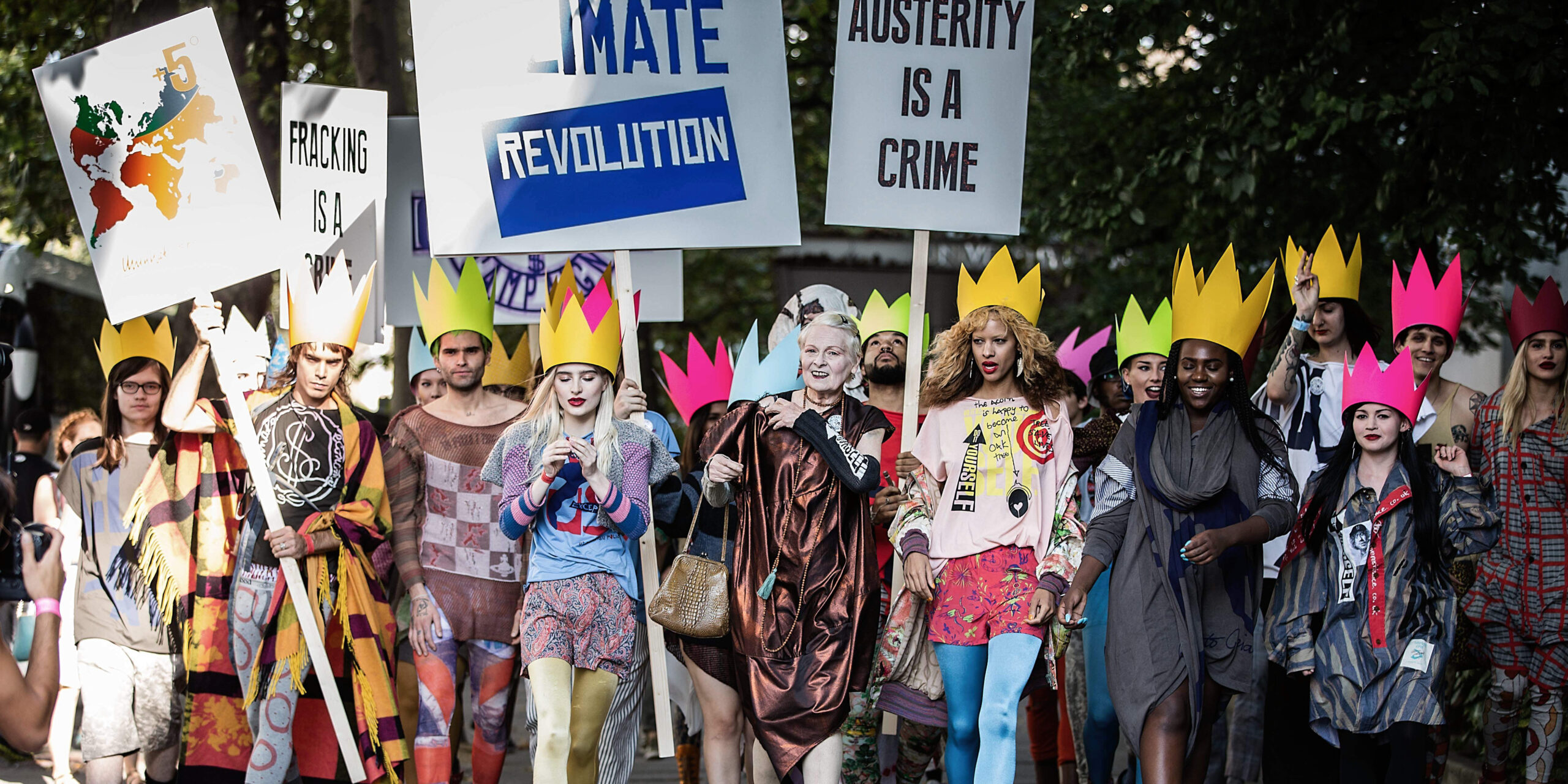A roadmap of the late Vivienne’s Westwood’s legacy as an unrelenting environmental activist.
Vivienne Westwood burst onto the scene in 1970 with the implosion of punk, spearheaded by the designer and her then-partner Malcolm McClaren. This was a decade before even the most nascent concerns regarding climate change emerged (the phrase was coined in 1979). Yet even then, Westwood’s design philosophy was pro-high-quality and anti-mass production. Over the next five decades, the visionary went from punk ingénue to not only the high priestess of British fashion but an inexorable climate activist and pioneer of the sustainable fashion movement. “She genuinely, genuinely cared. And she cared about you — she cared probably more about you and your future, more than you might. She was totally selfless, and she just wanted progression in humanity and humanity to wake up to what is coming,” says friend and longtime collaborator Daniel Lismore.
Below is a (by no means exhaustive) list of key moments from Westwood’s decades-long fight for our planet, from the 80’s to the designer’s passing last month at 81.
The 80s: A love letter to mother earth and a focus on quality tailoring
Although in the early 80s, climate change hadn’t yet become a mainstream concern, Westwood placed emphasis on what we now call the supply chain, ensuring that garments were made both locally and to last.
She and McLaren’s 1982 collection, Buffalo Girls/Nostalgia of Mud, was inspired by National Geographic magazine and served as a comment on Western culture and the traits it co-opted from other societies. As such, the collection referenced traditional South and North American and indigenous cultures, which were historically marginalized by Western greed and consumerism, and are now the first communities to suffer the effects of the climate crisis.
The 90s: An era of sacrifice in the name of sustainability
The Vivienne Westwood FW1990/91 collection, Portrait, saw the then ingénue and animal lover utilize fake fur for the first time. Two years later, in 1993, Westwood drew attention to endangered species by featuring endangered animal prints in the ultra-feminine Grand Hotel collection.
A name was given to Westwood’s design ethos in 1992 when the term ‘sustainability’ was established.
The Noughties: ‘Active resistance to propaganda.’
As the noughties crept in, so did the mainstreaming of the term ‘climate change.’ In 2007, Westwood officially ceased using real fur. That same year, the designer drafted a political and climate manifesto, ‘Active resistance to propaganda,’ viscerally condemning modern capitalism and mass consumption. “We have a choice: to become more cultivated, and therefore more human – or by not choosing, to be the destructive and self-destroying animal, the victim of our own cleverness (To be or not to be),” the manifesto’s introduction reads.
The 2010s: A vision solidified
The 2010s were busy for Westwood. Her dedication to the planet evolved to include theatrical demonstrations, including chopping off her hair in 2009 to raise climate change awareness.
In 2012, she launched the Climate Revolution at the London Paralympics closing ceremony, a non-profit and personal blog dedicated to environmental and political issues. In 2014, she posed in the shower for a PETA video to draw attention to the meat industry’s water consumption.
Perhaps the cause closest to Westwood’s heart was fracking prevention (an oil-extracting technique responsible for leaking millions of tons of methane into the atmosphere). In 2014 she attempted to deliver a parcel of asbestos to Prime Minister David Cameron’s Downing Street residence to highlight its parallels to asbestos. (Westwood’s former partner and the father of her son, Malcolm McLaren, died of cancer due to asbestos.) In 2013, Westwood and Lismore successfully thwarted fracking in Balcombe, England, by riding in a bus into a field before disembarking and convincing local pubgoers that fracking in their area would be detrimental to house prices. “We went to the next pub, and the people from the previous pub said, ‘you’ve got to tell everyone in the village what’s going to happen!’ So we stopped fracking in Balcombe because we went to the pub,” Lismore gushes, amused.
The following year, in an equally histrionic move, the designer drove an armored vehicle to Cameron’s Oxfordshire home again to protest fracking.
Despite declaring in the New York Times that a politician under capitalism is “a person who has the power to ignore suffering,” Westwood endorsed then-Labour leader Jeremy Corbyn leading up to the 2019 elections, having previously vocalized support for Britain’s Green party.
The 2020s: A final push
Amid the leadup to COP26 in Glasgow in 2021, Westwood released a film documenting her speech at Shakespeare’s Globe in London: a rallying cry for climate change action and a land-free economy. “Earth is our home, so on a global scale economy means sustainability. We don’t have that. We have no future. We have a financial system based on perpetual Trade War & Competition… True economy is based on the value of land. “Land belongs to NO ONE.” she read.
Despite her notorious love of the arts and galleries, in 2022, Westwood praised the activist group Stop Oil, who vandalized Van Gogh’s Sunflowers painting, “Young people are desperate. They’re doing something,” she justified on her blog.
Images courtesy of Vivienne Westwood





